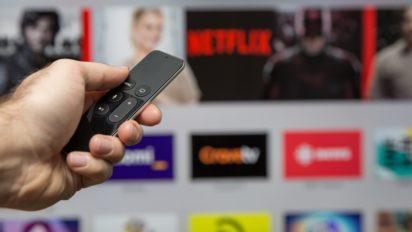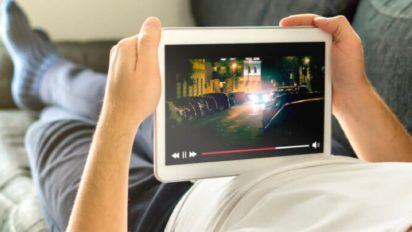According to streaming statistics in a 2019 report from Deloitte, Americans subscribe to an average of three paid video streaming services each.
It’s hard to overstate what a big deal that number is. Just three years ago, nearly half of the country subscribed to only one streaming service, and it was almost always Netflix. Americans are now more comfortable than ever building their own streaming bundle, and getting rid of their cable in the process.
Granted, caveats abound. One of those services is usually Amazon’s Prime Video, which has 112 million subscribers in the U.S., and is just one of the many perks of an Amazon Prime subscription. Likewise, Hulu has somewhat inflated subscriber numbers with $1/mo. offers and partnerships with Spotify.
The average cost of those three streaming services is subject to some debate. One poll from The Hollywood Reporter found that Americans spend $37/mo. on TV streaming, while a New York Times analysis put the number at just over $14/mo. — barely enough for a Netflix subscription.
Regardless of where the number actually lies, consumers say they only want to pay $21/mo. total for all streaming services combined. And with new streaming services like Apple TV+, Disney Plus, Peacock and HBO Max launching over the past year, that budget is getting stretched even further.
Original content on each streaming service
| Total monthly cost | Service one | Service two | Service three |
|---|---|---|---|
| $19.97 | Hulu w/ ads ($6.99) | Disney Plus ($7.99) | Apple TV+ ($4.99) |
| $27.47 | Netflix HD ($15.49) | Apple TV+ ($4.99) | Hulu w/ ads ($6.99) |
| $32.47 | Netflix HD ($15.49) | Disney Plus ($7.99) | Prime Video ($8.99) |
| $34.97 | Max ($14.99) | Showtime ($10.99) | Starz ($8.99) |
| $39.47 | Netflix HD ($15.49) | Max ($14.99) | Prime Video ($8.99) |
*Pricing per month plus taxes for length of contract. Additional fees and terms may apply. Pricing varies by location and availability. All prices subject to change at any time. May or may not be available based on service address. As of 7/18/22.
Of course, everyone always wants to pay the lowest price, but it’s still illuminating that there’s only one combination of three streaming services that meet that budget. And with more and more companies entering the streaming ring this year, that budget will soon be squeezed even more.
Which streaming services will get left behind?
To stay in the $17 to $27/mo. range that consumers say they’re willing to pay for streaming services, they’ll have to swap out something they already subscribe to in order to add any new ones. Here’s how subscriber numbers looked at the beginning of 2020, according to a report by the Wall Street Journal:
- Netflix – 61.3 million U.S. subscribers
- Amazon Prime Video – 42.2 million U.S. subscribers
- Apple TV Plus – 33.6 million U.S. subscribers
- Hulu – 31.8 million U.S. subscribers
- Disney Plus – 23.2 million U.S. subscribers
Add to that the 43 million HBO subscribers who automatically got HBO Max when it launched in May, and the field starts to look even more crowded.
It remains to be seen which services will prove essential to viewers, but we do have one hint. Streaming statistics in the Deloitte survey showed 57% of streaming users said they subscribed to access original content. For millennials, that number jumped all the way to 71%. By that measure, HBO Max clearly has the advantage.
When we analyzed which streaming services had the best original content, HBO came out on top by a wide margin. Even though Netflix has produced more than twice as many original shows and movies as HBO in about a third of the time, audiences and critics alike overwhelmingly favor HBO.
| Number of titles | Average IMDb rating | Average Rotten Tomatoes critic score | |
|---|---|---|---|
| Netflix | 1,177 | 6.8 | 73% |
| HBO Max | 521 | 7.3 | 85% |
| SHOWTIME | 284 | 7.3 | 70% |
| Prime Video | 222 | 7.2 | 76% |
| Hulu | 73 | 7.2 | 77% |
| STARZ | 40 | 7.5 | 74% |
| Disney+ | 36 | 7.1 | 83% |
| Quibi | 33 | 7.3 | 71% |
| Apple TV+ | 23 | 7.2 | 78% |
| CBS All Access | 14 | 7.0 | 73% |
If streaming services want to hold onto Americans’ streaming budget, they’ll have to provide shows and moves that viewers can’t get anywhere else. By that measure, HBO Max has a tremendous head start.
How do streaming services compare to cable and satellite TV?
Even though Americans are already maxed out when it comes to streaming services, they’re still substantially cheaper than traditional cable and satellite packages, which typically cost around $90/mo. when bundled with internet service.
Streaming packages vs. cable
| The Cord Cutter | The Sports Fan | The Minimalist | The On Demand Only | The Traditionalist |
|---|---|---|---|---|
| Sling Orange ($35/mo.) | Hulu + Live TV ($69.99/mo.) | TV antenna ($50) | Netflix ($15.49/mo.) | Spectrum (TV Select + Internet) ($90/mo.) |
| TV antenna ($50) | High-speed internet* ($60/mo.) | Netflix ($15.49/mo.) | Hulu w/ ads ($6.99/mo.) | Fees (up to $260/year) |
| Netflix ($15.49/mo.) | High-speed internet* ($60/mo.) | Amazon Prime Video ($8.99/mo) | Netflix ($15.49/mo.) | |
| Hulu w/ ads ($6.99/mo.) | Max ($14.99/mo.) | |||
| High-speed internet* ($60/mo.) | High-speed internet* ($60/mo.) | |||
| Year one: $1,460 | Year one: $1,560 | Year one: $956 | Year one: $1,278 | Year one: $1,526 |
*Average price of broadband internet in U.S.
Pricing per month plus taxes for length of contract. Additional fees and terms may apply. Pricing varies by location and availability. All prices subject to change at any time. May or may not be available based on service address. As of 7/18/22.
If you opt for “The Traditionalist” package, which gives you over 125 cable channels and Netflix, you’ll pay up to $1,526 per year. The “On Demand Only” viewer who subscribes to Netflix, Prime Video, Hulu and HBO Max and nothing else will pay almost $250 less over the course of a whole year.
This cost-benefit analysis seems to be shifting towards on-demand streaming services. For the first time ever, more people now subscribe to a streaming service than a traditional cable subscription.

Written by:
Joe SupanPrincipal Writer, Broadband Content
Joe is a senior writer for CNET covering home technology and broadband. Prior to joining CNET, Joe led MYMOVE’s moving coverage and reported on broadband policy, the digital divide, and privacy issues for the br…
Read more
Edited by:
Trey PaulEditor, Broadband Content
-
Featured
![What you need to stream TV: A beginner’s guide]() What you need to stream TV: A beginner’s guide Joe Supan — 9 min read
What you need to stream TV: A beginner’s guide Joe Supan — 9 min read -
Featured
![How much speed do you need for streaming?]() How much speed do you need for streaming? Taylor Gadsden — 6 min read
How much speed do you need for streaming? Taylor Gadsden — 6 min read -
Featured
![How to improve your streaming quality to get the best picture]() How to improve your streaming quality to get the best picture Camryn Smith — 3 min read
How to improve your streaming quality to get the best picture Camryn Smith — 3 min read
Latest
-
Monday, April 22, 2024
A guide to website error codesCamryn Smith — 4 min read
-
Friday, April 19, 2024
Can other Wi-Fi networks interfere with mine?Robin Layton — 4 min read
-
Thursday, April 18, 2024
Comcast introduces new pre-paid internet, mobile and streaming plansRobin Layton — 2 min read






